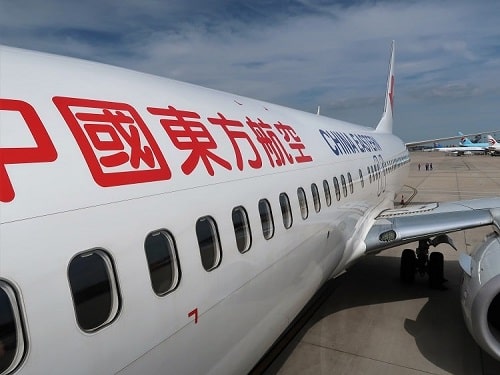I’ve lived, studied, and traveled all over China — and I’ve picked up a bunch of travel hacks that’ll save you time, money, and maybe even your dignity.
If you want more general China travel tips, then check out my 40 tips here.
Otherwise, read on for my best and slightly left-of-center China travel hacks.
I’m dying to share them with you!
1. Order food by photo

Point at the picture of the food you want. Image supplied by Mike Cairnduff.
Can’t speak a word of the local lingo?
Confused by your translation app telling you saliva chicken is good to eat?
Luckily, many Chinese restaurants have photos of every dish available.
Just point, grunt, and you’ll be served some delicious food in no time.
2. Fly with a dodgy Chinese airline

I don’t think Donghai flies internationally, but you get the idea. Image supplied by Mike Cairnduff.
This is a bit counterintuitive with my previous advice that you should avoid the no-frills Chinese airlines.
If you want the cheapest possible return flight to China, then I encourage you to choose an airline you’ve never heard of.
They’re generally much cheaper than the big four – Air China, China Southern, China Eastern and Hainan Airlines.
Can you believe I recently booked a return flight from Australia to Nanjing for just US$340?
I know, it’s crazy.
3. Go first class

There’s so much more room on a first class train carriage. Image supplied by Mike Cairnduff.
Scrimp on the airline, but be a boss on China’s high-speed trains with first class seats.
Yes, it costs a bit more, but in the scheme of things it is absolutely worth it.
The seat configuration is 2 seats on each side of the aisle, rather than 3 seats in cattle class.
So, if you’re taller, wider or heavier than the typical Chinese (and to be fair – that’s most of us), I highly recommend a first class train ticket.
Unfortunately, there are still some pigs in first class who will yell on their phone and act obnoxiously. But I can turn a blind eye to that if I’m able to stretch my legs.
First class seats are snapped up quickly, so book them as soon as tickets are released, which is about two weeks prior to travel.
4. Share your VPN

Share your VPN with your friends (just download before you arrive). Image supplied by Mike Cairnduff.
Are you a bit of tightwad, like me?
Then ask others in your travel group to buy the VPN.
Most VPN companies allow numerous connections at once (like these ones I recommend for China).
Boom! You’ve just saved yourself some money.
Just make sure the VPN is downloaded to your phone before you leave your country.
5. Dump your VPN

I wouldn’t leave for China without a standalone VPN, but you can. Image supplied by Mike Cairnduff.
If you don’t care about online privacy and anonymity in China, then forget the VPN altogether.
Most eSIMs are able to circumvent the Great Firewall of China and give you access to all your favorite foreign sites and apps.
However, because they use a Chinese carrier (such as China Unicom) then Big Brother may be watching.
If this doesn’t bother you, an eSIM is all you need.
6. Buy edible souvenirs

A cheap, fun and tasty souvenir. Image supplied by Mike Cairnduff.
No, I don’t mean edible gummies if that’s what you are thinking.
(Marijuana is banned in China, I’m afraid.)
I mean, buy some cheap Chinese snacks to bring home to your family and friends.
Each time I visit China, I buy a few bags of Chinese chips to throw in my suitcase.
I always choose Chinese lays chips as they have some gnarly flavors like fried crab and octopus balls.
My friends absolutely love them as they’re a unique and sensory gift. So much better than a fridge magnet!
Check out my page on traditional souvenirs from China if snack food ain’t your thing.
7. Tell them “No”
Speaking of souvenirs, if someone tries to sell you junk that you don’t want, tell them “no”.
Just say “bu yao” which means “I don’t want it”.
These two little, yet powerful words kill off any kind of conversation in China.
You can watch the short video above for help with pronunciation.
8. Charge daily

This airport bin says it is for power banks. Image supplied by Mike Cairnduff.
Most airlines won’t allow power banks in checked luggage.
And now, you can’t carry on power banks due to the fires they’ve been causing during flights.
There is an exception – if the power bank has a special Chinese logo then you’re OK to bring it.
But from my experience in China, this rule isn’t applied consistently and there are bins at airports where all power banks are expected to be dumped.
So this China travel hack is simple – charge your phone in your hotel every day instead of bringing a power bank.
9. Book a windowless room

My windowless hotel room in Beijing. Image supplied by Mike Cairnduff.
I did this for the first time recently.
The hotel in Beijing I wanted to stay at was booked out, apart from a windowless room.
I was only going to be in Beijing for a few days, and I had tours booked from morning to night, so I knew I would hardly spend any time in the room.
I took a deep breath and booked a room without a view.
It was the best decision ever as it saved me money and I still got to stay in the place I wanted.
The only downside: airflow was an issue and it got a little smelly.
10. Download Amap

You’ll love Amap (not a map). Image supplied by Mike Cairnduff.
Ever wondered what map to use in China?
Well, you can stop wondering and download Amap.
It’s a Chinese app which is translated into English.
There are other map apps but they’re less accurate or limited in functionality.
This is because the Chinese government only allows local companies to provide mapping services.
11. Screenshot everything

A screenshot of the Beijing subway map. Image supplied by Mike Cairnduff.
I do this all the time in China.
Whether it’s a QR code for entry to an attraction, or directions back to my hotel, I like to take a screenshot in case I have data issues or the web page is hard to access.
This makes things so much easier.
12. Dump and go

The old rural squatter. Image supplied by Mike Cairnduff.
The toilets in China are gross, no matter what the travel influencers say.
My best advice: do your business in your sparkling clean hotel loo before you go touring each day, rather than brave the experience of using a public toilet.
Nothing will prepare you for a sticky and stinky Chinese squat toilet.
Rural Chinese toilets are the worst – just take a look at the photo above!
If you can’t get your bowel movements going in the morning, then remember to carry toilet paper in your bag. It’s not provided in Chinese bathrooms.
Don’t forget your eSIM!
When you’re out and about in China, you need phone data to pay for things and use mapping, as I mentioned above.
It’s almost impossible to travel around China without a connected device.
Check out my China eSIM review here, or get the one I recommend most here:
Your eSIM can also give you access to all the foreign websites and apps that are blocked in China (even though technically it’s not a VPN).
Just remember to install the eSIM a day or so before you depart your country.
Visit the China travel blog if you want to dig deeper into China, or if you’re at the packing stage then check out my comprehensive packing list.












